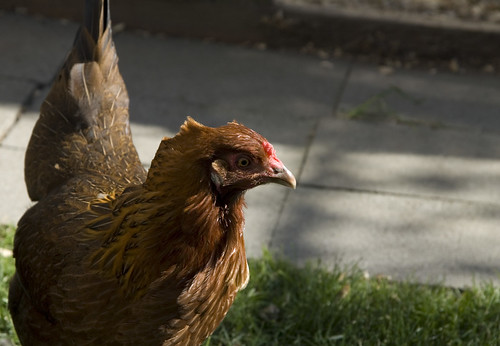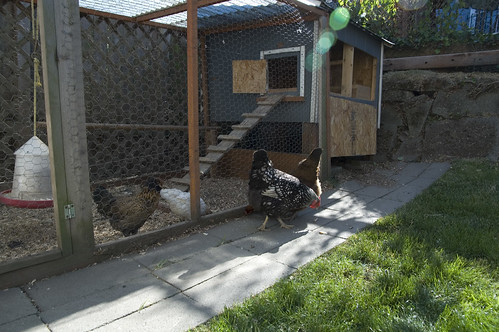
Despite the overwhelming city feel of most of the Seattle area, rural tendencies are becoming popular in many Central District neighborhoods as more and more urbanites take control of their own food supply. For the first of a series on urban agriculture, CDNews visited the Samuels residence on Columbia to see what they have cooped up in their back yard.
Tracey Samuels and his wife Tiffany have been reaping the benefits of a small collection of hens they’ve acquired in the past year. It began when a stray chicken wandered into the yard while Tracey was mowing, who then brought it to his daughters that took the hen in as a pet. But by request from Tiffany, and with the help of an experienced neighbor, Tracey built his own coop and run, purchased two more hens, and started harvesting eggs. The Samuels said that they get about one egg per hen per day, and give away a good portion of them to neighbors due to their daughters’ distaste for eggs. On top of that, the chicken manure composts into great fertilizer for other neighbors’ agricultural endeavors.
The Samuels said it only cost about $200 to set up the coop stock a month’s supply of food. They had just acquired two chicks to replace one of their original hens, costing them only $15 per chick. City code permits up to three domestic fowl in addition to up to three other small animals on single-family lots. “They are a really low maintenance animal, and they have become part of the family now,” said Tracey. “There’s no neighborhood disturbance either…they’re great”.
Editor’s note: Give a big welcome to Lucas Anderson, our summer news intern at Neighborlogs who will be working on some great stories here on CDNews for the next couple of months. Stay tuned for more in his series of urban farming in the CD.


I applaud their efforts in harvesting their own food. Living in the city, it’s nice to educate kids that eggs don’t grow in the supermarket. At the same time, it cracks me up that being as close as we are to downtown Seattle, we’re now likely to be waken up by a rooster in the morning.
http://www.youtube.com/watch?v=31y0Tv_UjoU
Last year, my neighbor put in raised beds and planted a lovely vegetable garden on 31st. However, he later reported to me that he didn’t get to harvest anything because pests (rats? racoons?) had eaten everything. It made me wonder how/if the neiborhood “pea patches” deal with this issue?
I’ve wondered the same thing, ZebraGirl – how do the pea patches and other farmers keep raccoons out of their gardens? I did see something the other day that I really loved the idea of – two young cherry trees planted in the parking strip on Howell by the YMCA. It got me to thinking that instead of planting chestnuts, the city could give out fruit trees for parking strip plantings, and the neighborhood around could enjoy the free fruit. (I know – messy windfall fruit on the sidewalks and likely turf wars among neighbors, but it’s an idea!)
My partner and I also have hens! They are wonderful pets and great to let wander in the gardens to eat the little pests. They also eliminated a rat problem for us as these girls took the rats on!! Don’t think they can handle coons though!
And no worries, most people who have hens do not keep roosters they are loud and can be quite mean. Plus, if you want to eat the eggs, it is best to keep roosters out of the hen house.
Watch Out For Coyotes; Haha
Great post. We haven’t gotten hens yet (maybe next year), but after our experiences at the Mad-P Patch, we’ve now started converting parts of our yard to grow veggies and fruits, too. Only the slugs and the birds have been our biggest pests to date. I think raccoons don’t like lettuce ;-)
The New York Times just had a good article on a major urban “Street Farmer” in Milwaukee, that, I think, complements this CDN story.
Great story. We garden at Immaculate P-Patch and in our own yard near there. We haven’t had any problems with coons or rats but the squirrels like strawberries and sunflowers. We put nets over the strawberries to protect them.
And I used to think the racoon family was so cute! A couple weeks ago, one dug under the coop and took away Gordita, only leaving a pile of her feathers. I piled pavers around (and on top) of the coop. Any other suggestions short of a smith & wesson 38 special?
Hey, great story, and kudos to all the urban farmers out there. And welcome to Lucas the Summer Intern! I just discovered the Central District News, and I’m already hooked. I look forward to great stories from Lucas all summer long.
Hmm, I wonder if you can have hens in a townhouse yard.
We just signed up for Seattle Tilth’s city chickens coop tour. Check it out: http://seattletilth.org/special_events/citychickenstour09
And yes, there’s even a coop in a townhouse on the tour!
You could probably kee two hens (they like company) in a townhouse yard. The coop does not need to be that big as long as you let them out for exercise. Also look at Bantams which are smaller hens.
As far as raccoons. My partner built a fortress. Our hen house floor is made of chicken wire also so that nothing could come u from underneath. We place the shavings over the floor so the hens do not actually walk on the wire. Iwill try to remember to get pcs to post. Our worries were a hawk that likes baby pigeons. So far so good! Only one rat infiltrated the coop through the door and he did not live to tell his friends! Our Beagle killed his friends!
We keep ducks for several years until the drakes kept getting killed by the Racoons. They would sneak in before dark and get them.
Great large eggs, and our garden was free of snails and slugs as they are great duck food!
We have a pair of hens in the backyard with an 8′ x 12′ area for them to run around in and a secure coop for sleeping. We are pretty careful about locking them up at dusk but we still lose one every so often to raccoons. Otherwise they are so easy to take care of. Top up the food and water, open and close the door, collect the eggs. The eggs are fabulous and we can toss them nearly everything from the kitchen. We have a bin to collect the droppings and wood shavings which turn into chickn-n-chips fertilizer.
$15 seems like alot for chicks unless it is out of season. Ours cost $1.25 each and a 50# sack of organic feed is about $15-18. Cedar shavings are only $10 for a big bundle that lasts a long time. You have to drive out of the city to find a decent feed store.